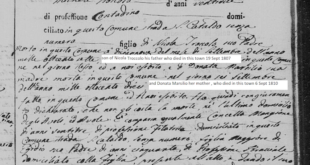Familysearch has done it again! (If I had a nickel for every time I’ve written that, I’d have $2.85!)
I have not been on Familysearch much, due to the fact that the records I need are only accessible from a Family History Center or an affiliate library, both of which are closed as of this writing.
So when I got in and saw the menu, I was perplexed. The Search menu starts with Records but then says “Images.” I didn’t know what it meant so I skipped it.
My curiosity finally got the better of me, and I clicked on it. “What’s this?” I thought. “A place to post historic family photos.” No that’s not what it is at all.
I was confronted with a screen asking me for the name of a place. As I typed “Triggiano” it came up with a full entry
The “Images” search contains records that are not yet in the main catalog. It’s sort of the attic or basement boxes of stuff no one has looked at yet.
So when I selected Triggiano, Bari, Apulia, Italy, I ended up with 60 search results.
 All it shows is what you see here:
All it shows is what you see here:
We have the year, the type of record, the number of images and the Title. In this case, there are death records from the 1930s and 1940s that are not in the catalog! Wow!
The rest of the 60 entries contain marriage allegati from the 1930s, so I can easily find the documents used to approve of each marriage, and the marriages themselves are not yet in the catalog at all.
So basically this is a place to look at possible documents you have not seen before. There is no way to search by name. You have to read each page. But it’s a great source of additional records and the best part is that none of them are restricted! You can work with these from home if you still can’t go to a family history center or affiliate library.
Obviously, you can type in the town you are from or are researching and see what it has.
There are many locations with no records, but it is possible that images are still to be loaded for those locations. They have the cemetery for Triggiano and the church listed as locations, but no records at this time. So don’t be surprised if nothing shows up. But it’s worth a look!
A record type I have seen very little of is the Morti Allegati. These are death records of people who died in other towns, including the USA, and whose deaths were reported to the town they came from. This is especially important if someone died in a war.
The records I am finding are in the 1930s which might show if someone from my town died in the battles in North Africa that Mussolini was engaged in at the time. These same deaths are recorded in the regular deaths under Parte Seconde but the Parte Seconde are all written longhand and are hard to read.
The Morti Allegati are formatted like regular records and are much easier to read. In a number of instances, I found Chicago death certificates for people who were reports and copied into the Morti Allegati.
I hope this help you find unexpected gems for your research. I liken it to going up to the attic and finding a trunk full of old photos and documents you didn’t know you had! Happy hunting!
 Fra Noi Embrace Your Inner Italian
Fra Noi Embrace Your Inner Italian








